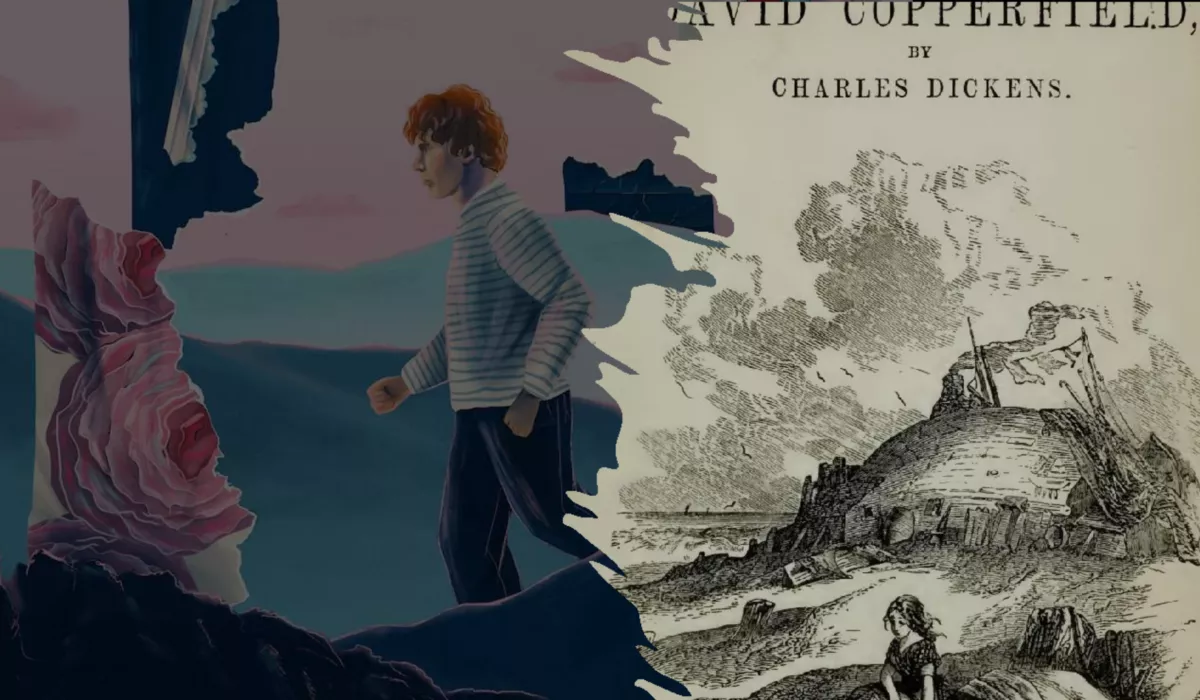Thinking
ORPHANS, ADDICTS & FALLEN WOMEN: SHAME AND ANGER IN NOVELS BY CHARLES DICKENS AND BARBARA KINGSOLVER
This is the first stage of a longer-term project which is to pair a series of novels – a contemporary one from the last 50 years alongside a 19th Century one – and to compare them along technical and aesthetic lines. However, since the contemporary novel I want to consider – Demon Copperhead – has been mapped directly onto the plot and character web of David Copperfield, rather than a set of cousins with shared characteristics, its considerable overlap of subject matter makes this pair more of a parent and child.
A self-confessed “small town kid” who grew up in Kentucky, Barbara Kingsolver has recently, after many years of deracination and travel, returned to the hills and creeks of the intensely lyrical but poor, eroded region of Lee County where she researched the work that would go on in 2022 to win the Pulitzer prize, an award for novels about America. Kingsolver had been wanting to write about the 1990s/2000s Opioid crisis of the Appalachian Mountains at least two years before she went to stay in Bleak House, Broadstairs, Kent, where challenging her belief that no one would want to read a politicised work about orphans and poverty, Dickens, who had done exactly that in David Copperfield, seemed to speak to her, giving her permission to do so. He suggested, moreover, through David’s first person narrative that the child should be the teller of his own desperate story. Dickens’s own ‘favourite child’ which he reread before starting Great Expectations – and notably, the Dickens novel most cherished by both Sigmund Freud and Virginia Woolf – this Victorian blueprint has been a highly influential work for novelists such as Henry James, Dostoyevsky, James Joyce and another modernist, Franz Kafka who like Kingsolver, wrote his own version of it. Looking out to the tempestuous waves that inspired both novels’ brutal climaxes, there and then at the actual desk where Dickens began Copperfield, Kingsolver sat down to write.
Due to how it has been exploited and abandoned by the backbreaking industries of coal and tobacco, Kingsolver likens Appalachia to an internal colony of the US, a ravaged society that she wanted to depict from the inside. Her furious narrator Demon, who she says is “bloated with anger”, certainly seems to spit out the narrative about the post-industrial desert of Lee County which was subsequently pumped full of narcotic addiction. Directed by the now discredited Sackler Foundation-owned Purdue drugs company, its latest efforts to avoid ultimate prosecution through declaring bankruptcy having failed just a few weeks ago, the opioid industry tightened its grip on an already impoverished people. Although I have not seen the figures, we can assume that like the first deep wave of Covid in this country, a disproportionate number of people from ethnic minorities will have been affected. “Once upon a time” our unlikely hero summarises, “we had our honest living that was God and country. Then the world turns, and there’s no God anymore, no country…..Everything that could be taken is gone. Mountains left with their heads blown off, rivers running black. My people are dead of trying, or headed that way, addicted as we are to keeping ourselves alive.”

Once it had mysteriously, and very questionably, achieved approval, Oxycontin was sold to doctors as an unbeatable salve for intense pain, and strenuously advertised as relatively unaddictive. Scandalously, Lee county in particular was targeted for its high numbers of people needing relief, with the opioids being billed as “Not the usual stuff you have to take every four hours, this one lasts around the clock!” The large number of overdoses was owing to the sheer potency of what is of course morphine; when crushed and inhaled, the effect could be lethal. After Demon’s own injury, the grim, potentially fatal side-effects of opioid addiction manifest themselves and, again, referencing the now dwindling importance of religion to the community, Demon reports how “It becomes your job, staving off the dope sickness for another day. Then it becomes your God. Nobody ever wanted to join that church.” In this intergenerational tale of trauma being passed on as the interwoven stories of “Four demons spawned by four different starving hearts” suggests, the biologist-trained Kingsolver, seems to be asking with Demon, “Where does the road to ruin start?”
Such parentless, rudderless children that populate the pages of Demon Copperhead are closely related of course to Dickens himself who, recalling how a relative used him at the age of 7 to work in a Blacking factory in the Strand registered a catastrophic sense of abandonment: “From Monday morning until Saturday night, I had no advice, no counsel, no encouragement, no consolation, no assistance, no support, of any kind, from anyone that I can call to mind, as I hope to go to heaven….I was so young and childish, and so little qualified – how could I be otherwise? – to undertake the whole charge of my own existence….” Like Demon who is suitably ambivalent about his hopelessly addicted, if kind, mother, Dickens had conflicting feelings towards his father – model for the affectionate if improvident character of Micawber – who despite some tenderness, was utterly disinterested in his son’s future. Dickens senior even seems to have even supported his young son’s occupation. In fact, the traumatic first-hand experience of this wasteland of childhood poverty and homelessness seems to have been the psychoanalytical impetus behind his first-person retrospective novel of Copperfield, and forming much of the key 10th and 11th chapters are unedited passages, such as this one, that he had already written for an autobiography: “it is a matter of some surprise to me, even now, that I can have been so easily thrown away at such an age. A child of excellent abilities, and with strong powers of observation, quick, eager, delicate, and soon hurt bodily or mentally, it seems wonderful to me that nobody should have made any sign in my behalf.” As Demon diagnoses of the state of social welfare nearly 200 years later, “all the adults had gone off somewhere and left everything in our hands.” And infamously of course, Dickens’s own father had gone off to prison for debt. Today, in the UK, results from a recent survey compute record numbers of children – 31,000 – living in temporary accommodation.

Comparable to the help David receives, there are, nonetheless, golden patches for Demon “where everything was going to be okay thanks to the people that had your back”, and as Kingsolver has said, she wanted her work, however marginally, to honour the community spirit of the county where people often bring up orphans from other families. However, for both writers, it is art that has to step in where democratic systems most catastrophically fail. For Dickens, literature is the personal response to the suffering of Child Labour, while for Kingsolver, it is a vehement response to the wholescale persecution of the Appalachian people. Our privileged position here at North London should, I would suggest, make us as students of literature, deliberately seek out texts which confront social issues.
The immediacy of Dickens’ tortured memory about the Blacking factory – “I see and hear, rather than remember as I write about it” – characterises his novel’s visceral, sensory prose as in David’s description of the waterside warehouse in Blackfriars: “The discolourings, dirt and rottenness of the panelled rooms “are things”, he writes, “not of many years ago, in my mind, but of the present instant. They are all before me, just as they were in the evil hour when I went among them for the first time.” Moreover, when relating the physical abuse by his step-father, this novel about memory rather than merely of memory, older David cannot help but enter the present tense in all its vivid buoyancy. Alongside its picaresque tales of invention and resilience in avoiding becoming a “little robber or vagabond”, this bildungsroman also eschews any prolonged sense of sentimentality through its searing detailing of its hero’s less savoury character traits: David’s destructive emotional immaturity, his snobbery, his guilt and self-pity. However, it is Dickens’s life-long legacy of furious shame arising from this time in the factory that dominates the emotional tenor of much of his confessional narrative: “The deep remembrance of the sense I had, of being utterly without hope now; of the shame I felt in my position; of the misery it was to my young heart to believe that day by day what I had learned, and thought, and delighted in….would pass away from me, never to be brought back any more, cannot be written….”
Much less tricksy and nuanced than Dickens’s complex Russian Doll narrative relationships between Dickens the Author, David the novelist and David the growing boy, Demon directly and solely addresses the reader in trying to figure it all out as the recovering drug addict he has become. For instance, at one point he admits “At the time, I thought my life couldn’t get any worse” before going on, “Here’s some advice: Don’t ever think that.” What she might have lost in complexity, Kingsolver gains in irony and immediacy in Demon’s breathless narrative as it flies along. After all, as Demon says of an addict’s life, “Sometimes a good day lasts all of about ten seconds.”
There are of course, in an essentially Christian, redemptive vision such as that of Dickens, intimations of the wider, potentially benign universe beyond. For instance, when he remembers running away from the factory to find his Aunt Betsey, an outcast “against whom house-doors were locked, and house-dogs barked”, the older novelist David imagines himself “looking wildly at the stars that were glistening and glimmering above”. Similarly, alongside the hope contingent in a first-person narrator who must have survived the harrowing story he is recounting, is Demon’s quiet love of nature as imbibed from a would-be guardian, Mr Peg. Not many years later at the funeral of his young drug addict wife, Demon notes, however, in a post-Romantic Eliotelion disillusion borne from the realisation that all he had done for Dori “added up to nothing”, how “The day itself was cruel, a blue sky to rip your damn heart from your lungs. Trees in bud, yellow jonquils exploding out of the ground, dogwoods standing around in their petticoats.” More acerbically, the disinterested woodpecker, for instance, is “minding their business and not actually giving a damn about yours.”
Indeed, confounding the deep sense of nostalgia running through David Copperfield, a story about the loss of a home which the narrator is continually seeking through his physical or writerly travels, is the curse of Demon’s idealistic character, the questing and yearning of which seem to situate him in the wrong era – “I was born to wish for more than I can have. No little fishing hole for Demon, he wants the whole ocean.” He pitifully studies both nests – that no birds live in – and ramshackle uninhabitable homes, and even conflates the two – “government housing that didn’t cost much more than a birdhouse” – because Demon, like David, has never had a home of his own.
Nowhere is such yearning more present than in both novels’ many descriptions of funerals and graveyard visits, Copperfield opening with the “shadowy remembrance” David has of his “first associations with his [father’s] white gravestone.” Pre-empting some of the ramifications of grief work in Freud’s essay ‘Mourning and Melancholia’, he makes repeated returns – again, both physical and psychological – to his parents’ grave: “As if I had come home to build my castles in the air at a living mother’s side.” David also admits, in a narrative peppered by the words “shadowy” and shadow”, that he is trying to dream up sustenance from nothing other than a “fanciful picture of my mother in her youth, before I came into the world.” Such imaginary pictures are both alive yet mortal, imbued as they are with both the sunny street of Canterbury and the more frequently shaded “grey Cathedral, with the rooks sailing round the towers.”
In other early memories of David, reality and the imagination work together to produce real glowing objects but also, in an often comic novel darkened by shadows, in one example, horrors of “dark corridors” and fear of graveyards are engendered from the story of the alive yet simultaneously dead Lazarus, archetype of the ever-present past. The retrospective narrative recalls his mother’s funeral – in all its high Victorian glamour – in the most astonishingly sensuous signifiers: “The very air of the best parlour… the bright condition of the fire, the shining of the wine in the decanters….The sound of the quavery organ, old ladies stinking of perfume. The wasps, this whole slew of them, buzzing and buzzing at the coloured windows way up high….” a passage made plangent by the ubiquitous “sabbath stillness of the time”. It is such literary “fecundity and [the] apparent irreflectiveness”, Virginia Woolf observed, that “make creators of us and not merely readers and spectators.” When Kingsolver’s Demon confesses that he “always liked looking at things more than talking about them”, he owes a debt to his older brother David, the novelist. On behalf of his friend Tommy who has had eight different foster homes far from where his parents had originally been buried, Demon would also even seem to enter the mode of pastoral elegy when he relates how Tommy would gather “up all the pink [tobacco] flowers that you were supposed to throw on the ground and walk on” to adorn his makeshift and cumulative little set of eight graves. Like Dickens, Kingsolver is expert at merging Literary history with socio-economics; as Kingsolver tells us, the foster system in America, scandalously, is set up for profit.
“What matters in a story is the heart of its hero”, says Demon, and both heroes then are broken-hearted throughout. David’s assessment that “ No man’s imagination can overstep the reality” of his suffering, is mirrored in the contemporary novel when the voice of June says on behalf of Kingsolver: “It’s not natural for boys to lose their minds….It happens because they’ve had too many things taken away from them.” Like David, Demon who calls himself “a lowlife”, experiences prolonged hunger when working at a meth lab masquerading as a landfill site, at the same time as his foster parents are pocketing his wages. Then, in parallel with David’s shame, Demon records being ridiculed and tortured by classmates for his poverty as he relates in an incident of being suddenly adorned with a set of new clothes, with typically mordant wit: “Now they’d all think I was just that much more pitiful, because of trying. Loser is a cliff. Once you’ve gone over, you’re over.” As Samuel Beckett notes “it’s not the despair that gets you, it’s the hope.” Demon is equally moved when a social worker asks him what he wants to be when he grows up. “Mainly alive’, he ruefully comments in a narrative that, like Copperfield, is tonally rich in its co-mingling of irony and calamity.
Also a novel like Copperfield about social class, Demon deftly, systematically and damningly contextualises a litany of social deprivation: “A ten-year-old getting high on pills. Foolish children. This is what we’re meant to say: Look at their choices, leading to a life of ruin. But lives are getting lived right now, this hour, down in the dirty cracks between the toothbrushed nighty-nights and the full grocery carts, where those words don’t pertain. Children, choices. Ruin, that was the labor and materials we were given to work with.”

David Copperfield is also as intensely a political novel as that of Kingsolver for whom all “art is political”, for its depictions of Fallen Women and prostitutes of which, according to Henry Mayhew in 1857 there were known to be at least 8 and a half thousand in the Capital. Since Victorian society held that women should be the guardians of morality and should be sexually completely passive, Martha’s fall into prostitution is shocking, and accordingly, Dickens’s readers would have accepted her misery. And yet despite the transportation of both Martha and Little Em’ly to Australia – again, expected by the readers – Dickens, the man, seems to have been much more hopeful about the potential of rehabilitation of such women in English Society. He was closely involved, we know, with the benefactor Angela Burdett-Coutts in the establishment of Urania Cottage, a place for fallen women that he helped to oversee in Shepherds Bush where he stipulated they were to be treated with respect and dignity unlike, for instance, the more usual Lock asylums where they were held to prevent the spread of contagion and disease. Indeed in 1853, Dickens would go on to interview some of his Urania Cottage residents for Household Words.
A combination of two of the three causes of prostitution – poverty and degeneracy, with seduction being the third one, – Martha is described as “bold, and haggard, and flaunting, and poor”. Structurally, the novel powerfully aligns the fallen woman with the working orphan – as does Copperhead – through the setting of the Thames Embankment where Davy had laboured earlier in the novel. He does so in extraordinarily grim, deeply-layered and personified depictions of an alluvial industrial wasteland superimposed on the place of punishment associated by Dickens – from his own background – with impoverished children: “There were neither wharves nor houses on the melancholy waste of road near the great blank Prison. A sluggish ditch deposited its mud at the prison walls….In one part, carcases of houses, inauspiciously begun and never finished, rotted away. In another, the ground was cumbered with rusty iron monsters of steam-boilers, wheels cranks…. Slimy gaps and causeways, winding among old wooden piles, with a sickly substance clinging to the latter, like green hair, and ravages of last year’s handbills offering rewards for drowned men fluttering above high-water mark, led down through the ooze and slush to the ebb tide.” The descriptive pathos returns us, inevitably, to its real subject, the suicidal and ethereal, Martha, “As if she were part of the refuse it had cast out, and left to corruption and decay, the girl we had followed strayed down to the river’s brink, and stood in the midst of this night-picture, lonely and still, looking at the water.” Then, in her identification with the powerful and ubiquitous Thames, comes Dickens’s great poetic rendering of the social causes that have destroyed this young woman’s life. “Oh, the river…I know it’s like me…..I know that I belong to it…It comes from country places, where there was once no harm in it – and it creeps through the dismal streets, defiled and miserable – and it goes away, like my life, to a great sea, that is always troubled – and I feel that I must go with it!” That David himself calls her “a prostrate image of humiliation and ruin” makes Dickens sympathetic to her extreme suffering and what’s more, innocent, as underscored when she had earlier noted to Emily when crying for help, “I was once like you.” Moreover, that she will not take money for leading David and Mr Peggoty to the now fallen Em’ly suggests how steeped Dickens was in the Christian property of redemption.

In our later novel about social inequality, Kingsolver too exercises great sympathy for a catalogue of fallen women, lost not through prostitution, but through domestic abuse, as endured by Mariah Peggot who kills her husband in self-defence and goes to jail, and drug addiction, as depicted through Dori about whom Demon precis: “ The wonder is that you could start life with nothing, end with nothing, and lose so much in between”. In a nod to Dickens’ structural device of binaries and doublings, like his own mother with whom he has a notably unsentimental relationship as her pitifully jejune carer, Demon’s young wife Dori – like his mother – is just “Another OD in Lee County”.
As I remarked earlier, both Copperfield and Copperhead are political responses to the scandalous failings of society, and while not fully remedial, alongside such anger, both novelists do proffer ideas about the power of art to protest, making both works self-reflexive to a great extent. I have been reminded how it was an artist – Nan Goldin – who has spearheaded the crusade against the so-called philanthropist family of the Sacklers. In his creation of the eccentric Traddles who reacts to each school beating by the drawing of skeletons, producing, in one particularly unfair instance, “A whole churchyard full of skeletons swarming all over his Latin dictionary”, Dickens assesses the value of art as therapy in a cruel world. Equally, Tommy, his young American counterpart and a long time orphan, doodles skeletons even more frenziedly than Traddles: “For him, though, it was like blood, this thing that came out of him whenever he got hurt.” When beaten on behalf of Fast Forward, Dickens’ opportunistic Steerforth villain, Tommy goes “for the Guinness record of most skeletons ever drawn on a grain bag.” Certainly, these two self-reflexive novels are not merely bildungsromans then, but also powerful kunstleromans. While Dickens recounts the development of the writer David has become by the end of the novel, Kingsolver also follows Demon’s vocational pull towards remedial cartoons in which the characters, Superman-like, save children such as he and Tommy once were. His own website comic strip does “some of our famous local histories through the eyes of skeletons. Knox Mine disaster, Natural tunnel train wreck….The Incapables, a strip about a junkie couple trying to keep house.” But crucially, the key for Demon who tried to make it “sad and true to the laughable mess of addicted youth” is that it should be “also bitter” since “a good story doesn’t just copy life, it pushes back on it” in the same way as these two powerful literary works do. In graduating from both Tommys’ repetitive, primitive and almost involuntary skeleton drawings, David and Demon make a strong case for the imagination as a more useful, therapeutic, possibly transformative process.
Yet when the “innocent romantic boy, making his imaginative world out of such strange experiences and sordid things!” matures as a writer and learns how to be faithful to reality, he simultaneously predicts the eternal pain this might instigate. Dickens does this in an atypically staccato syntax, which halts as David starts to relay the crisis of his life – the drowning of his surrogate family member which has been caused by David’s best friend: “It is no worse, because I write of it. It would be no better, if I stopped my most unwilling hand. It is done. Nothing can undo it; nothing can make it otherwise than as it was.” Kingsolver too hints at the recurring pain and even annihilation of the self that comes about through the application of the imagination to such searing experience. As Demon diagnoses “At some point the shows, comic books, drawing, and my dreams all got mashed up so it was like there wasn’t any me anymore.” And so as I have tried to suggest through a glance at their work, for both Dickens and Kingsolver, there is deep paradox running through the idea of art as therapy. However powerless it may be to dispel the legacy of shame and anger left in the wake of social injustice and institutional corruption, at the same time, the aesthetic struggle is indispensable in distilling the truth of experience. These two novels suggest that such particularly indignant art can help us to endure the damage done to us or those around us. And, while it can’t necessarily bring pressure to bear on those institutions that facilitate such harm, it can make us, as readers, deeply informed and therefore, just as indignant.
Dr Ruth McLoughlin, Teacher of English – Nicholson Lecture



